How Does the Execution of the Pilates Method and Therapeutic Exercise Influence Back Pain and Postural Alignment in Children Who Play String Instruments? A Randomized Controlled Pilot Study
Abstract
1. Introduction
2. Materials and Methods
2.1. Study Design
2.2. Participants
2.3. Interventions
2.4. Assessments, Study Variables, and Measuring Instruments
2.4.1. Study Variables and Measuring Instruments
First Outcome Measurement: Back Pain Perceived before, during, and after Practicing with the String Instrument
Second Outcome Measurement: Postural Alignment: Shoulders and Hips
2.5. Statistical Analysis
3. Results
3.1. Primary Outcomes: Pain Perceived before, during, and after Practicing with the String Instrument
3.2. Secondary Outcomes
3.3. Third Outcomes: Correlation of the Experimental Group Post–Pre-Treatment Difference in Back Pain (Pre–During–After) with Age and Time Playing the Instrument
4. Discussion
5. Conclusions
Supplementary Materials
Author Contributions
Funding
Acknowledgments
Conflicts of Interest
References
- Sardà, R.E. En Forma. Ejercicios para Músicos, 1st ed.; Ediciones Paidós Ibérica: Barcelona, Spain, 2003. [Google Scholar]
- Echan, C.; Ackermann, B.J. Evidence-informed physical therapy management of performance-related musculoskeletal disorders in musicians. Front. Psychol. 2014, 5, 706. [Google Scholar] [CrossRef]
- Hoenig, K.; Müller, C.; Herrnberger, B.; Sim, E.J.; Spitzer, M.; Ehret, G.; Kiefer, M. Neuroplasticity of semantic representations for musical instruments in professional musicians. Neuroimage 2011, 56, 1714–1725. [Google Scholar] [CrossRef] [PubMed]
- Brandfonbrener, A. Etiologies of medical problems in performing artists. In Performing Arts Medicine; Science & Medicine: Narberth, PA, USA, 2010; p. 25. [Google Scholar]
- Ackermann, B.J.; Driscoll, T.; Kenny, D.T. Musculoskeletal pain and injury in profesional orchestral musicians in Australia. Med. Probl. Perform. Artist 2012, 27, 181–187. [Google Scholar] [CrossRef]
- Leaver, R.; Harris, E.C.; Palmer, K.T. Musculoskeletal pain in elite professional musicians from British symphony orchestras. Occup. Med. 2011, 61, 549–555. [Google Scholar] [CrossRef] [PubMed]
- Paarup, H.M.; Baelum, J.; Holm, J.W.; Manniche, C.; Wedderkopp, N. Prevalence and consequences of musculoskeletal symptoms in symphony orchestra musicians vary by gender: A cross-sectional study. BMC Musculoskelet. Disord. 2011, 12, 223. [Google Scholar] [CrossRef]
- Cerveró, C.G.; Ruiz, J.M.; Sanchis, L.R.; Ros, C.R. Pain Perception in Clarinetists with Playing-Related Pain After Implementing a Specific Exercise Program. Med. Probl. Perform. Artist 2018, 33, 238–242. [Google Scholar] [CrossRef]
- Gasenzer, E.R.; Klumpp, M.J.; Pieper, D.; Neugebauer, E.A.M. The prevalence of chronic pain in orchestra musicians. Ger. Med. Sci. 2017, 15, 1–9. [Google Scholar] [CrossRef]
- Ioannou, C.I.; Altenmüller, E. Approaches to and Treatment Strategies for Playing-Related Pain Problems Among Czech Instrumental Music Students: An Epidemiological Study. Med. Probl. Perform. Artist 2015, 30, 135–142. [Google Scholar] [CrossRef]
- Rensing, N.; Schemmann, H.; Zalpour, C. Musculoskeletal Demands in Violin and Viola Playing: A Literature Review. Med. Probl. Perform. Artist 2018, 33, 265–274. [Google Scholar] [CrossRef]
- Lee, H.S.; Park, H.Y.; Yoon, J.O.; Kim, J.S.; Chun, J.M.; Aminata, I.W.; Cho, W.J.; Jeon, I.H. Musicians’ Medicine: Musculoskeletal Problems in String Players. Clin. Orthop. Surg. 2013, 5, 155–160. [Google Scholar] [CrossRef]
- Moraes, G.F.D.S.; Antunes, A.P. Musculo skeletal disorders in professional violinists and violists. Systematic review. Acta Ortop. Bras. 2012, 20, 43–47. [Google Scholar] [CrossRef] [PubMed]
- Kovero, O.; Kononen, M.; Pirinen, S. The effect of violin playing on the bony facial structures in adolescents. Eur. J. Orthod. 1997, 19, 369–375. [Google Scholar] [CrossRef] [PubMed][Green Version]
- Adam, G.; Wang, K.; Demaree, C.J.; Jiang, J.S.; Cheung, M.; Bechara, C.F.; Lin, P.H. A Prospective Evaluation of Duplex Ultrasound for Thoracic Outlet Syndrome in High-Performance Musicians Playing Bowed String Instruments. Diagnostics 2018, 8, 11. [Google Scholar] [CrossRef] [PubMed]
- Kochem, F.B.; Silva, J.G. Prevalence of Playing-related Musculoskeletal Disorders in String Players: A Systematic Review. J. Manip. Physiol. Ther. 2018, 41, 540–549. [Google Scholar] [CrossRef] [PubMed]
- Nordio, S.; Bernitsas, E.; Meneghello, F.; Palmer, K.; Stabile, M.R.; Dipietro, L.; Di Stadio, A. Expiratory and phonation times as measures of disease severity in patients with Multiple Sclerosis. A case-control study. Mult. Scler. Relat. Disord. 2018, 23, 27–32. [Google Scholar] [CrossRef] [PubMed]
- Zatorre, R.J.; Chen, J.L.; Penhune, V.B. When the brain plays music: Auditory-motor interactions in music perception and production. Nat. Rev. Neurosci. 2007, 8, 547–558. [Google Scholar] [CrossRef] [PubMed]
- Joret, M.E.; Germeys, F.; Gidron, Y. Cognitive inhibitory control in children following early childhood music education. Musicae Sci. 2017, 21, 303–315. [Google Scholar] [CrossRef]
- Hennessy, S.L.; Sachs, M.E.; Ilari, B.; Habibi, A. Effects of Music Training on Inhibitory Control and Associated Neural Networks in School-Aged Children: A Longitudinal Study. Front. Neurosci. 2019, 13, 1080. [Google Scholar] [CrossRef]
- Degé, F.; Schwarzer, G. The Effect of a Music Program on Phonological Awareness in Preschoolers. Front. Psychol. 2011, 2, 124. [Google Scholar] [CrossRef]
- Rydeard, R.; Leger, A.; Smith, D. Pilates-based therapeutic exercise: Effect on subjects with nonspecific chronic low back pain and functional disability: A randomized controlled trial. J. Orthop. Sports Phys. Ther. 2006, 36, 472–484. [Google Scholar] [CrossRef]
- Britto, M.T.; Slap, G.B.; DeVellis, R.F.; Hornung, R.W.; Atherton, H.D.; Knopf, J.M.; DeFriese, G.H. Specialists Understanding of the Health Care Preferences of Chronically Ill Adolescents. J. Adolesc. Health 2007, 40, 334–341. [Google Scholar] [CrossRef] [PubMed]
- Mah, J.K.; Tough, S.; Fung, T.; Douglas-England, K.; Verhoef, M. Adolescent quality of life and satisfaction with care. J. Adolesc. Health 2006, 38, 607. [Google Scholar] [CrossRef] [PubMed]
- Ávalos, F.S.; Florensa, S.G.T. La Columna vertebral del niño en crecimiento: Desviaciones. Offarm 2011, 30, 66–71. [Google Scholar]
- Bridwell, K. Columna Vertebral. Available online: https://www.spineuniverse.com/espanol/anatomia/columna-vertebral (accessed on 24 September 2020).
- González-Gálvez, N.; Marcos-Pardo, P.J.; Trejo-Alfaro, H.; Vaquero-Cristóbal, R. Effect of 9-month Pilates program on sagittal spinal curvatures and hamstring extensibility in adolescents: Randomised controlled trial. Sci. Rep. 2020, 10, 1–8. [Google Scholar] [CrossRef]
- Taylor, N.F.; Dodd, K.J.; Shields, N.; Bruder, A. Therapeutic exercise in physiotherapy practice is beneficial: A summary of systematic reviews 2002-2005. Aust. J. Physiother. 2007, 53, 7–16. [Google Scholar] [CrossRef]
- Lundborg, B.; Grooten, W.J.A. Resistance training for professional string musicians: A prospective intervention study. Med. Probl. Perform. Artist 2018, 33, 102–110. [Google Scholar] [CrossRef]
- Vos, T.; Flaxman, A.D.; Naghavi, M.; Lozano, R.; Michaud, C.; Ezzati, M.; Shibuya, K.; Salomon, J.A.; Abdalla, S.; Aboyans, V.; et al. Years lived with disability (YLDs) for 1160 sequelae of 289 diseases and injuries 1990-2010: A systematic analysis for the Global Burden of Disease Study 2010. Lancet 2012, 380, 2163–2196. [Google Scholar] [CrossRef]
- Jönsson, T.; Hansson, E.E.; Thorstensson, C.A.; Eek, F.; Bergman, P.; Dahlberg, L.E. The effect of education and supervised exercise on physical activity, pain, quality of life and self-efficacy—An intervention study with a reference group. BMC Musculoskelet Disord 2018, 19, 198. [Google Scholar] [CrossRef]
- Moreno, R.C.; Morera, C.F. Manual Completo de Pilates Suelo; Paidotribo: Barcelona, Spain, 2009. [Google Scholar]
- Campos, R.R.; Dias, J.M.; Pereira, L.M.; Obara, K.; Barreto, M.S.; Siva, M.F.; Mazuquin, B.F.; Christofaro, D.G.; Fernandes, R.A.; Iversen, M.D.; et al. The effect of the Pilates method on the physical conditioning of healthy subjects: A systematic review with meta-analysis. J. Sports Med. Phys. Fit. 2015, 56, 864–873. [Google Scholar]
- Kloubec, J.A. Pilates for improvement ofmuscle endurance, flexibility, balance, and posture. J. Strength Cond. Res. 2010, 24, 661–667. [Google Scholar] [CrossRef]
- Geremia, J.M.; Iskiewicz, M.M.; Marschner, R.A.; Lehnen, T.E.; Lehnen, A.M. Effect of a physical training program using the Pilates method on flexibility in elderly subjects. AGE 2015, 37, 1–12. [Google Scholar] [CrossRef][Green Version]
- Lopes, S.; Correia, C.; Félix, G.; Lopes, M.; Cruz, A.; Ribeiro, F. Immediate effects of Pilates based therapeutic exercise on postural control of young individuals with non-specific low back pain: A randomized controlled trial. Complement. Ther. Med. 2017, 34, 104–110. [Google Scholar] [CrossRef] [PubMed]
- Kuntze, G.; Nesbitt, C.; Whittaker, J.L.; Nettel-Aguirre, A.; Toomey, C.; Esau, S.; Doyle-Baker, P.K.; Shank, J.; Brooks, J.; Benseler, S.; et al. Exercise Therapy in Juvenile Idiopathic Arthritis: A Systematic Review and Meta-Analysis. Arch. Phys. Med. Rehabil. 2018, 99, 178–193. [Google Scholar] [CrossRef] [PubMed]
- Klepper, S.; Mano Khong, T.T.; Klotz, R.; Gregorek, A.O.; Chan, Y.C.; Sawade, S. Effects of Structured Exercise Training in Children and Adolescents with Juvenile Idiopathic Arthritis. Pediatr. Phys. Ther. 2019, 31, 3–21. [Google Scholar] [CrossRef] [PubMed]
- García-Soidán, J.L.; Giraldez, V.A.; Zagalaz, J.C.; Lara-Sánchez, A.J. Does pilates exercise increase physical activity, quality of life, latency, and sleep quantity in middle-aged people? Percept. Mot. Skills 2014, 119, 838–850. [Google Scholar] [CrossRef]
- Mikkelsson, L.O.; Nupponen, H.; Kaprio, J.; Kautiainen, H.; Mikkelsson, M.; Kujala, U.M. Adolescent flexibility, endurance strength, and physical activity as predictors of adult tension neck, low back pain, and knee injury: A 25 year follow up study. Br. J. Sports Med. 2006, 40, 107–113. [Google Scholar] [CrossRef]
- Cibinello, F.U.; Neves, J.C.D.J.; Carvalho, M.Y.L.; Valenciano, P.J.; Fujisawa, D.S. Effect of Pilates Matwork Exercises on Posterior Chain Flexibility and Trunk Mobility in School Children: A Randomized Clinical Trial. J. Bodyw. Mov. Ther. 2020, 24, 176–181. [Google Scholar] [CrossRef]
- De Araújo, M.E.A.; Da Silva, E.B.; Mello, D.B.; Cader, S.A.; Salgado, A.S.I.; Dantas, E.H.M. The effectiveness of the Pilates method: Reducing the degree of non-structural scoliosis, and improving flexibility and pain in female college students. J. Bodyw. Mov. Ther. 2012, 16, 191–198. [Google Scholar] [CrossRef]
- Aladro-Gonzalvo, A.R.; Araya-Vargas, G.A.; Machado-Díaz, M.; Salazar-Rojas, W. Pilates-based exercise for persistent, non-specific low back pain and associated functional disability: A meta-analysis with meta-regression. J. Bodyw. Mov. Ther. 2013, 17, 125–136. [Google Scholar] [CrossRef]
- Lim, E.C.W.; Poh, R.L.C.; Low, A.Y.; Wong, W.P. Effects of pilates-based exercises on pain and disability in individuals with persistent nonspecific low back pain: A systematic review with meta-analysis. J. Orthop. Sports Phys. Ther. 2011, 41, 70–80. [Google Scholar] [CrossRef]
- Suh, J.; Choi, H.S.; Kwon, A.; Chae, H.W.; Eom, S.; Kim, H.S. Once-weekly supervised combined training improves neurocognitive and psychobehavioral outcomes in young patients with type 1 diabetes mellitus. J. Pediatr. Endocrinol. Metab. 2019, 32, 1–10. [Google Scholar] [CrossRef]
- Deci, E.L.; Ryan, R.M. The “what” and “why” of goal pursuits: Human needs and the self-determination of behavior. Psychol. Inq. 2000, 11, 227–268. [Google Scholar] [CrossRef]
- Demetriou, Y.; Reimers, A.K.; Alesi, M.; Scifo, L.; Borrego, C.C.; Monteiro, D.; Kelso, A. Effects of school-based interventions on motivation towards physical activity in children and adolescents: Protocol for a systematic review. Syst. Rev. 2019, 8, 113. [Google Scholar] [CrossRef] [PubMed]
- Knuth, A.G.; Hallal, P.C. Temporal trends in physical activity: A systematic review. J. Phys. Act. Health 2009, 6, 548–559. [Google Scholar] [CrossRef] [PubMed]
- Hadders-Algra, M. Typical and atypical development of reaching and postural control in infancy. Dev. Med. Child Neurol. 2013, 55, 5–8. [Google Scholar] [CrossRef] [PubMed]
- Van Houdenhove, B.; Verheyen, L.; Pardaens, K.; Luyten, P.; Van Wambeke, P. Rehabilitation of decreased motor performance in patients with chronic fatigue syndrome: Should we treat low effort capacity or reduced effort tolerance? Clin. Rehabil. 2007, 21, 1121–1142. [Google Scholar] [CrossRef] [PubMed]
- Detsch, C.; Luz, A.M.H.; Candotti, C.T.; de Oliveira, D.S.; Lazaron, F.; Guimarães, L.K.; Schimanoski, P. Prevalence of postural changes in high school students in a city in southern Brazil. Pan Am. J. Public Health 2007, 21, 231–238. [Google Scholar] [CrossRef] [PubMed]
- Ossipov, M.H.; Morimura, K.; Porreca, F. Descending pain modulation and chronification of pain. Curr. Opin. Support. Palliat. Care 2014, 8, 143–151. [Google Scholar] [PubMed]
- Infomed. Visual Analog Scale. Available online: http://www.sld.cu/galerias/pdf/sitios/rehabilitacion/eav_1.pdf (accessed on 24 September 2020).
- Huskisson, E.C. Measurement of pain. Lancet 1974, 304, 1127–1131. [Google Scholar] [CrossRef]
- Puig-Diví, A.; Escalona-Marfil, C.; Padullés-Riu, J.M.; Busquets, A.; Padullés-Chando, X.; Marcos-Ruiz, D. Validity and reliability of the Kinovea program in obtaining angles and distances using coordinates in 4 perspectives. PLoS ONE 2019, 14, e0216448. [Google Scholar] [CrossRef] [PubMed]
- Kaufman-Cohen, Y.; Ratzon, N.Z. Correlation between risk factors and musculoskeletal disorders among classical musicians. Occup. Med. 2011, 61, 90–95. [Google Scholar] [CrossRef] [PubMed]
- Fishbein, M.; Middlestadt, S.E.; Ottati, V.; Straus, S. Medical problems among ICSOM musicians: Overview of a national survey. Med. Probl. Perform. Artist 1988, 3, 1–8. [Google Scholar]
- Grimmer, K.; Williams, M. Gender-age environmental associates of adolescent low back pain. Appl. Ergon. 2000, 31, 343–360. [Google Scholar] [CrossRef]
- Ludvig, D.; Preuss, R.; Larivière, C. The effect of extensible and non-extensible lumbar belts on trunk muscle activity and lumbar stiffness in subjects with and without low-back pain. Clin. Biomech. 2019, 67, 45–51. [Google Scholar] [CrossRef] [PubMed]
- Mendonça, T.M.; Terreri, M.T.; Silva, C.H.; Neto, M.B.; Pinto, R.M.; Natour, J.; Len, C.A. Effects of pilates exercises on health-related quality of life in individuals with juvenile idiopathic arthritis. Arch. Phys. Med. Rehabil. 2013, 94, 2093–2102. [Google Scholar] [CrossRef] [PubMed]
- Cruz-Díaz, D.; Martínez-Amat, A.; Osuna-Pérez, M.C.; de La Torre-Cruz, M.J.; Hita-Contreras, F. Short- and long-term effects of a six-week clinical Pilates program in addition to physical therapy on postmenopausal women with chronic low back pain: A randomized controlled trial. Disabil. Rehabil. 2016, 38, 1300–1308. [Google Scholar] [CrossRef] [PubMed]
- Andersen, L.N.; Mann, S.; Juul-Kristensen, B.; Søgaard, K. Comparing the impact of specific strength training vs general fitness training on professional symphony orchestra musicians: A feasibility study. Med. Probl. Perform. Artist 2017, 32, 94–100. [Google Scholar] [CrossRef] [PubMed]
- Chan, C.; Driscoll, T.; Ackermann, B. Development of a specific exercise programme for professional orchestral musicians. Inj. Prev. 2013, 19, 257–263. [Google Scholar] [CrossRef] [PubMed]
- Kava, K.S.; Larson, C.A.; Stiller, C.H.; Maher, S.F. Trunk endurance exercise and the effect on instrumental performance: A preliminary study comparing Pilates exercise and a trunk and proximal upper extremity endurance exercise program. Music Perform. Res. 2010, 3, 1–30. [Google Scholar]
- Key, J. “The core”: Understanding it, and retraining its dysfunction. J. Bodyw. Mov. Ther. 2013, 17, 541–559. [Google Scholar] [CrossRef]
- Zheng, Y.; Ke, S.; Lin, C.; Li, X.; Liu, C.; Wu, Y.; Xin, W.; Ma, C.; Wu, S.; Wieczorek, A. Effect of core stability training monitored by rehabilitative ultrasound image and surface electromyogram in local core muscles of healthy people. Pain Res. Manag. 2019, 2019. [Google Scholar] [CrossRef]
- Schreiber, S.; Parent, E.C.; Moez, E.K.; Hedden, D.M.; Hill, D.L.; Moreau, M.; Lou, E.; Watkins, E.M.; Southon, S.C. Schroth physiotherapeutic scoliosis-specific exercises added to the standard of care lead to better cobb angle outcomes in adolescents with idiopathic scoliosis—an assessor and statistician blinded randomized controlled trial. PLoS ONE 2016, 11. [Google Scholar] [CrossRef] [PubMed]
- Kuo, Y.L.; Tully, E.A.; Galea, M.P. Sagittal spinal posture after pilates-based exercise in healthy older adults. Spine 2009, 34, 1046–1051. [Google Scholar] [CrossRef]
- Emery, K.; de Serres, S.J.; McMillan, A.; Côté, J.N. The effects of a Pilates training program on arm-trunk posture and movement. Clin. Biomech. 2010, 25, 124–130. [Google Scholar] [CrossRef]
- Hornsby, E.; Johnston, L.M. Effect of Pilates Intervention on Physical Function of Children and Youth: A Systematic Review. Arch. Phys. Med. Rehabil. 2020, 101, 317–328. [Google Scholar] [CrossRef]
- Jago, R.; Jonker, M.L.; Missaghian, M.; Baranowski, T. Effect of 4 weeks of Pilates on the body composition of young girls. Prev. Med. 2006, 42, 177–180. [Google Scholar] [CrossRef]
- Jung, M.E.; Bourne, J.E.; Little, J.P. Where does HIT Fit? An Examination of the Affective Response to High-Intensity Intervals in Comparison to Continuous Moderate- and Continuous Vigorous-Intensity Exercise in the Exercise Intensity-Affect Continuum. PLoS ONE 2014, 9, e114541. [Google Scholar] [CrossRef]
- Oliveira, B.R.R.; Santos, T.M.; Kilpatrick, M.; Pires, F.O.; Deslandes, A.C. Affective and enjoyment responses in high intensity interval training and continuous training: A systematic review and meta-analysis. PLoS ONE 2018, 13. [Google Scholar] [CrossRef] [PubMed]
- Malik, A.A.; Williams, C.A.; Weston, K.L.; Barker, A.R. Perceptual Responses to High- and Moderate-Intensity Interval Exercise in Adolescents. Med. Sci. Sports Exerc. 2018, 50, 1021–1030. [Google Scholar] [CrossRef] [PubMed]
- Epstein, L.H.; Roemmich, J.N. Reducing sedentary behavior: Role in modifying physical activity. Exerc. Sport Sci. Rev. 2001, 29, 103–108. [Google Scholar] [CrossRef] [PubMed]
- Timbedake, W.; Farmer-Dougan, V.A. Reinforcement in Applied Settings: Figuring Out Ahead of Time What Will Work. Psychol. Bull. 1991, 110, 379–391. [Google Scholar] [CrossRef] [PubMed]
- Destrebecqz, A.; Cleeremans, A. Can sequence learning be implicit? New evidence with the process dissociation procedure. Psychon. Bull. Rev. 2001, 8, 343–350. [Google Scholar] [CrossRef] [PubMed]
- Gheysen, F.; Fias, W. Dissociable neural systems of sequence learning. Adv. Cogn. Psychol. 2012, 8, 73–82. [Google Scholar] [CrossRef] [PubMed]
- Candler, C.; Meeuwsen, H. Implicit learning in children with and without developmental coordination disorder. Am. J. Occup. Ther. 2002, 56, 429–435. [Google Scholar] [CrossRef] [PubMed]
- Bixby, W.R.; Spalding, T.W.; Hatfield, B.D. Temporal dynamics and dimensional specificity of the affective response to exercise of varying intensity: Differing pathways to a common outcome. J. Sport Exerc. Psychol. 2001, 23, 171–190. [Google Scholar] [CrossRef]
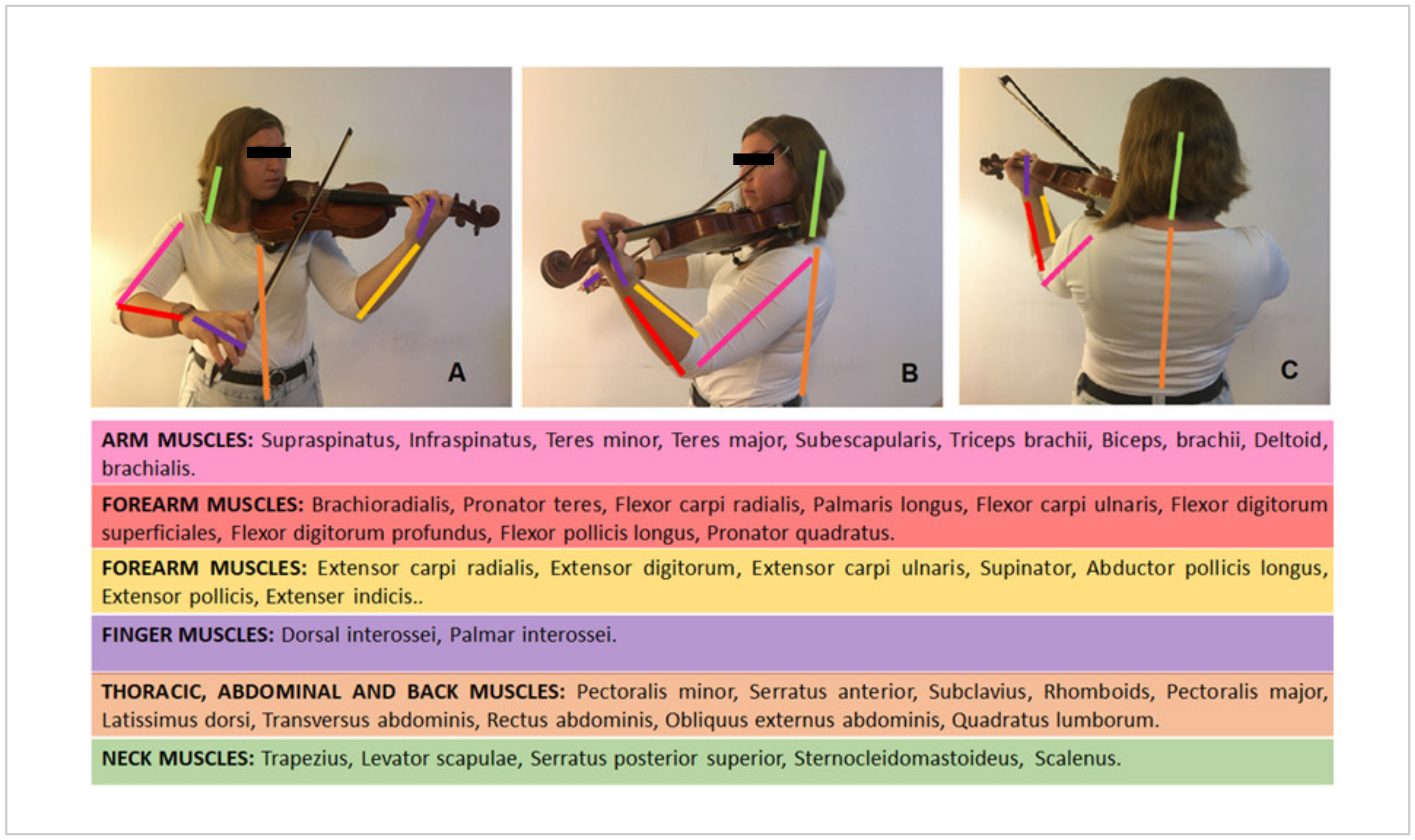
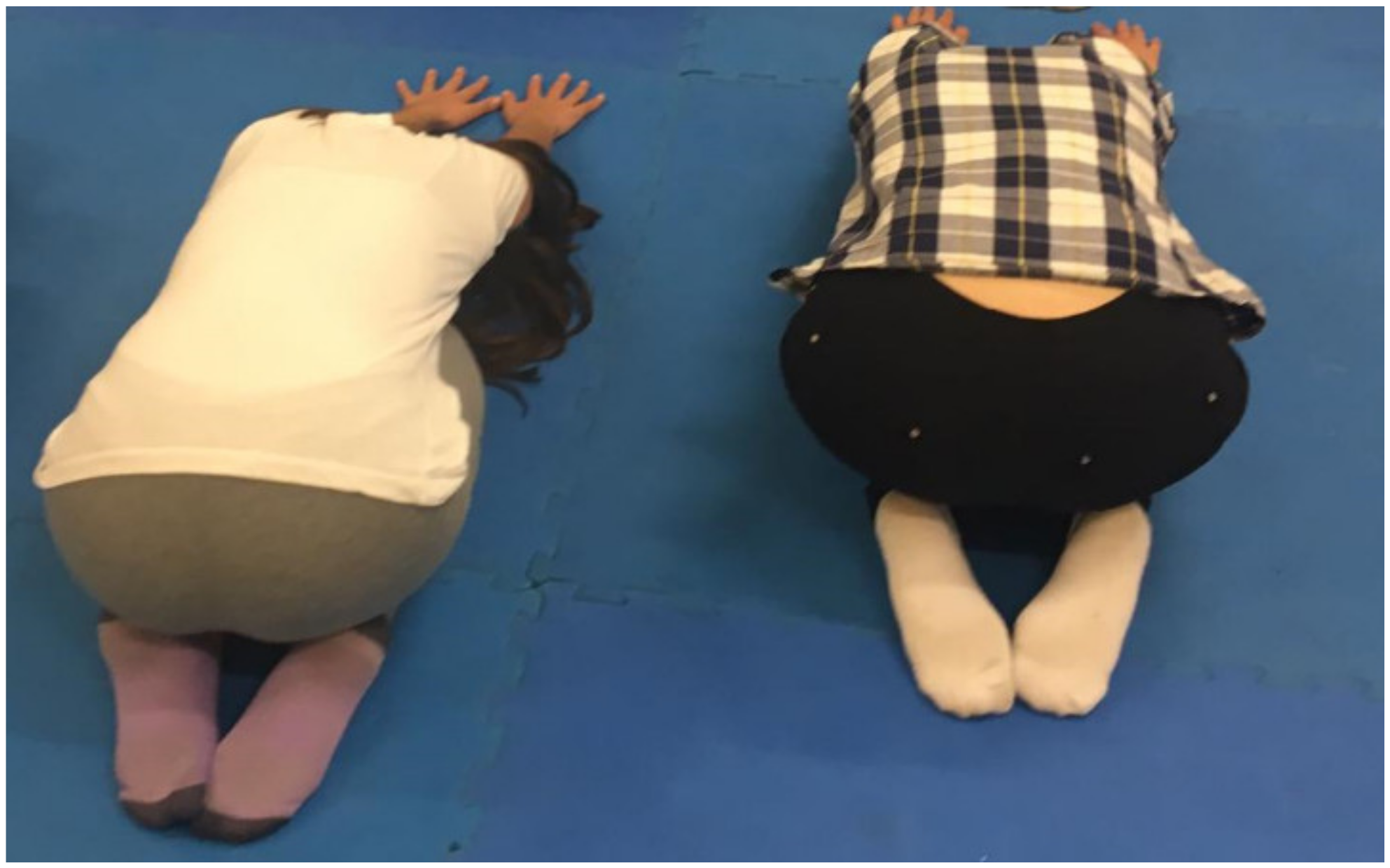
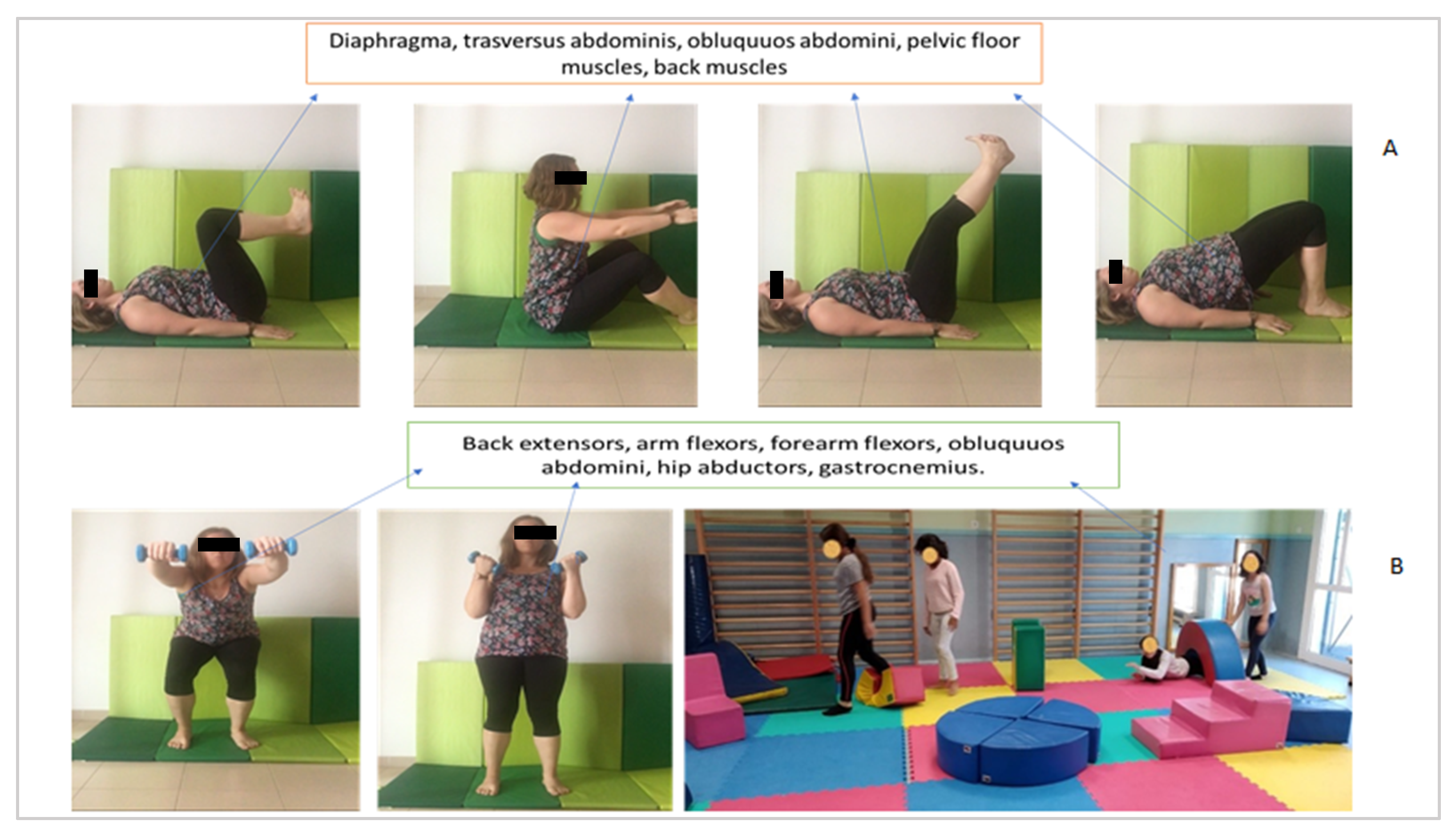
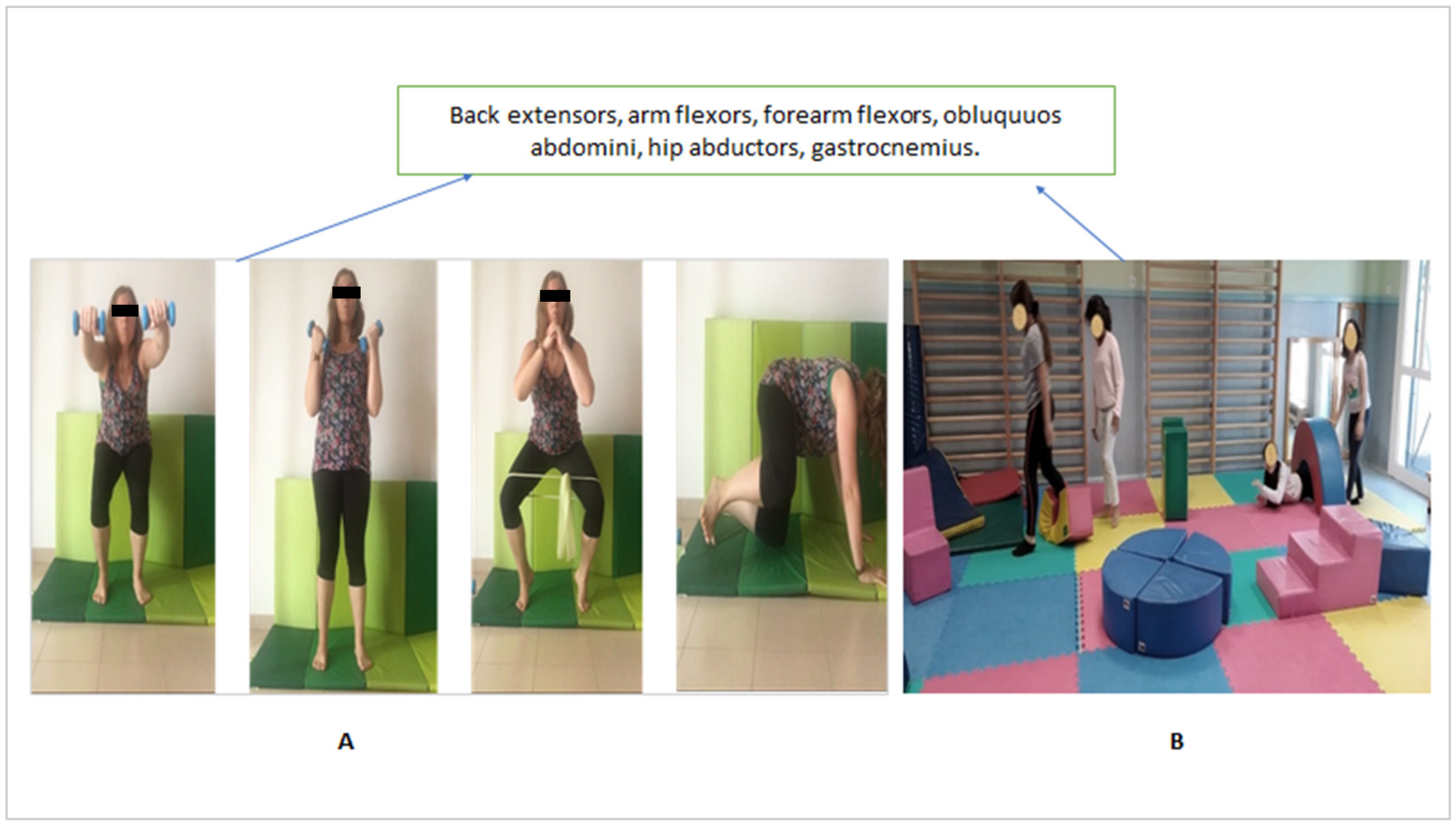
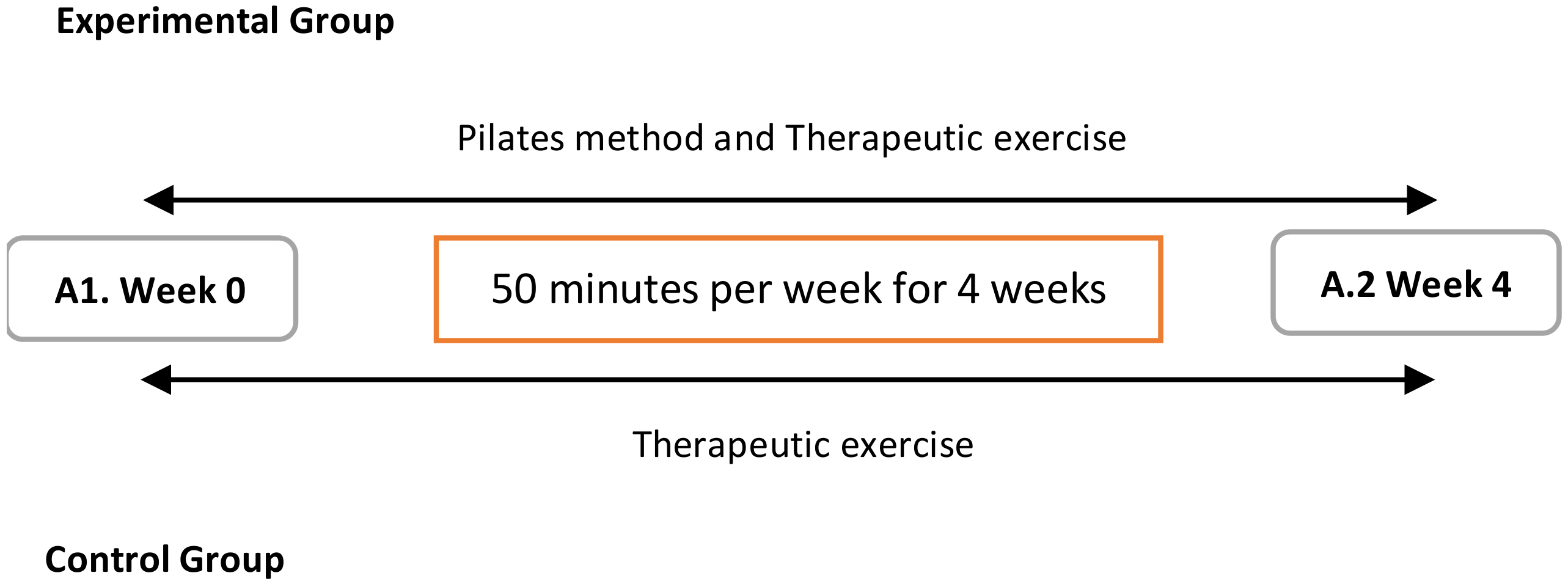
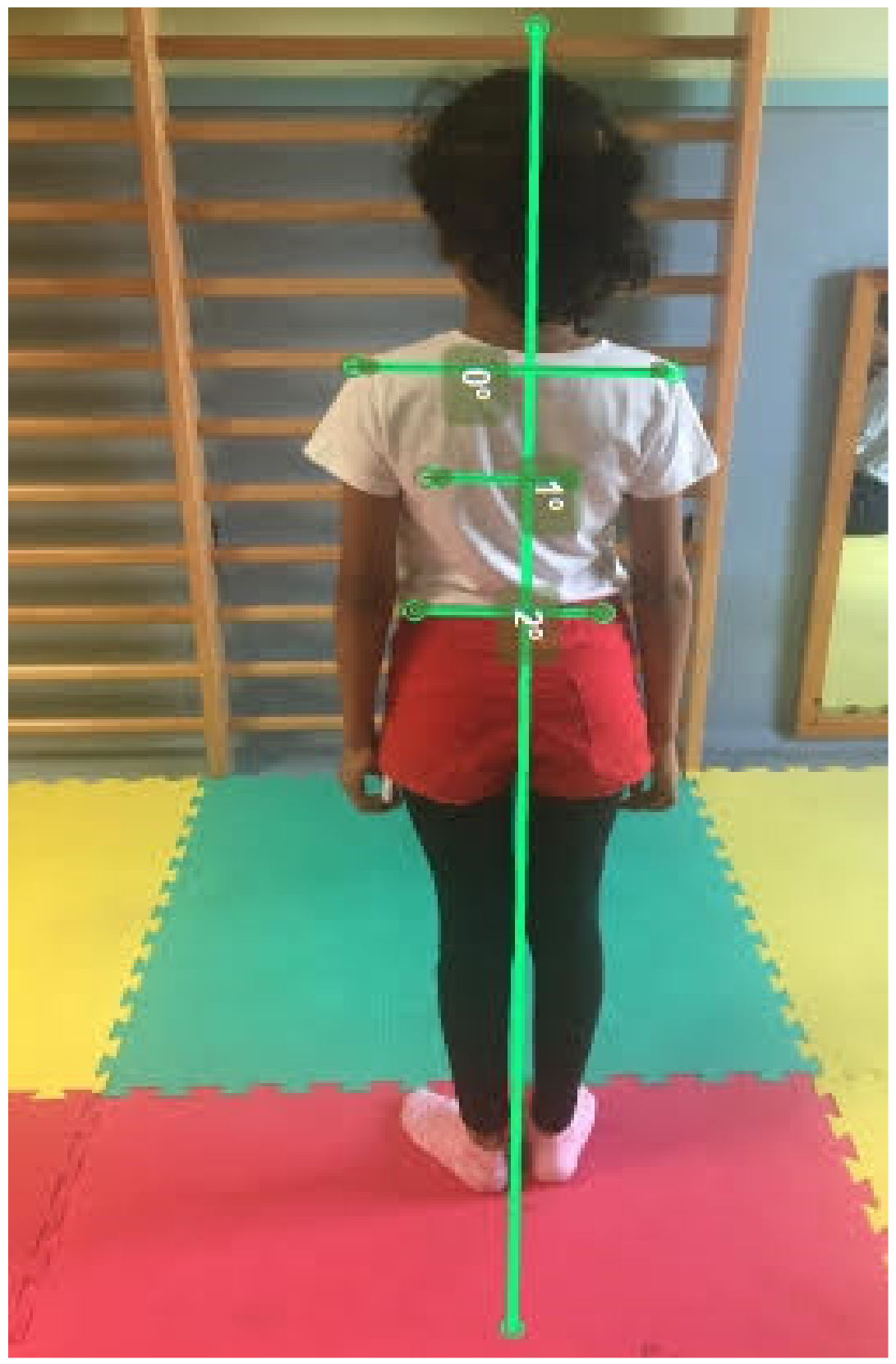

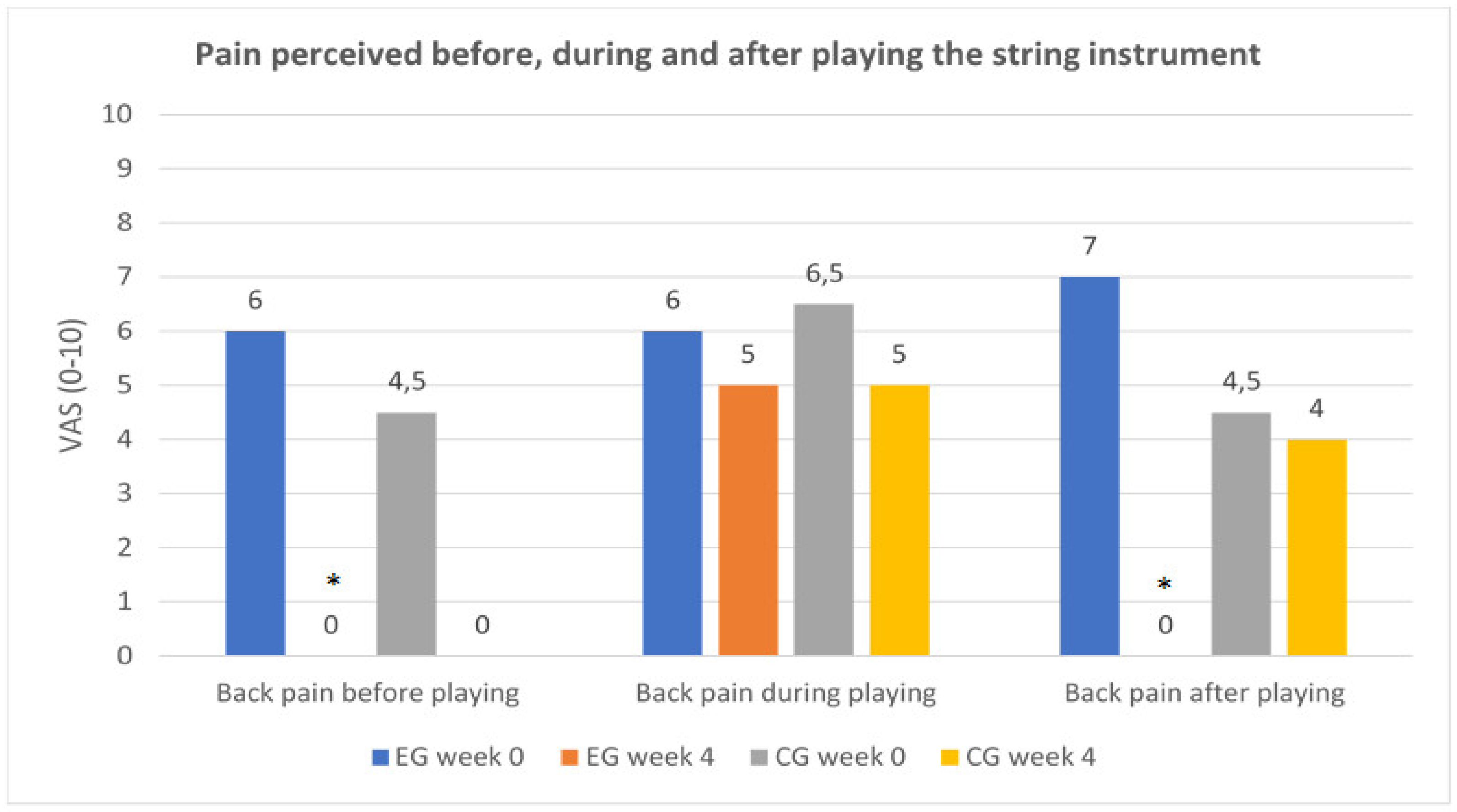
| Groups | Intervention Protocols Examples |
|---|---|
| Therapeutic Exercise | Each 50-minute class was divided into warm-up, training, and stretching:
|
| Pilates Method and Therapeutic Exercise | Each 50 minute-class was divided into warm-up, training, and stretching:
|
| Experimental Group | Control Group | p-Value | |
|---|---|---|---|
| Female (%) | 61.54 | 75 | - |
| Male (%) | 38.46 | 25 | - |
| Age (years), mean (SD) | 13 (1.6) | 11.17 (0.72) | < 0.01 |
| Time playing the instrument(months), mean(SD) | 23.53 (11.66) | 34 (16.84) | 0.6 |
| Time spent playing the instrument per week (Monday- Friday), mean expressed in hours (SD) | 4 (0.32) | 4 (0.35) | 1 |
| Years of experience playing the instruments in the music school, mean (SD) | 2 (0.24) | 3 (0.29) | 0.6 |
| Music initiation age, mean (SD) | 10.2 (0.65) | 8.5 (0.53) | 0.04 |
| String instrument played: | |||
| Violin/viola n. (%) | 5 (38.46) | 4 (33.33) | - |
| Cello n. (%) | 4 (30.77) | 4 (33.33) | - |
| Double bass n. (%) | 4 (30.77) | 4 (33.33) | - |
| Self-report outcome median (IQR) | |||
| VAS (0–10) | |||
| -Back pain before playing | 6 (0, 8) | 4.50 (0, 9) | 0.7 |
| -Back pain during practice | 6 (0, 8) | 6.50 (0, 9) | 0.9 |
| -Back pain after playing | 7 (0, 8) | 4.50 (0, 9) | 0.6 |
| Measured outcome | |||
| median (IQR) | |||
| Kinovea (movement angles, degrees º) | |||
| -Shoulders | 2 (0, 6) | 1 (0, 5) | 0.6 |
| -Hips | 2 (0, 6) | 1 (0, 5) | 0.6 |
| Self-Report Outcome Median (IQR) VAS (0–10) | Experimental Group Week 0 | Experimental Group Week 4 | p-Value | Control Group Week 0 | Control Group Week 4 | p-Value |
|---|---|---|---|---|---|---|
| Back pain before playing | 6 (0,8) | 0 (0, 8) | 0.04 * | 4.50 (0, 9) | 0 (0, 7) | 0.08 |
| Back pain during practice | 6 (0, 8) | 5 (0, 7) | 0.24 | 6.50 (0,9) | 5 (0, 7) | 0.34 |
| Back pain after playing | 7 (0, 8) | 0 (0, 7) | 0.01 * | 4.50 (0,9) | 4 (0, 7) | 0.46 |
| Measured Outcome Median (IQR) Kinovea (Movement Angles, Degreesº) | Experimental Group Week 0 | Experimental Group Week 4 | p-Value | Control Group Week 0 | Control Group Week 4 | p-Value |
|---|---|---|---|---|---|---|
| -Shoulders | 2 (0, 6) | 2 (1, 4) | 0.09 | 1 (0, 5) | 0 (0, 2) | 0.7 |
| -Hips | 2 (0, 6) | 2 (0, 5) | 0.57 | 1 (0, 4) | 0 (0, 3) | 0.1 |
| Experimental Group’s Post–Pre-Treatment Difference | Age | Time Playing the Instrument |
|---|---|---|
| Back pain before playing the instrument | −0.59 * | −0.05 |
| Back pain during playing the instrument | 0.04 | 0.11 |
| Back pain after playing the instrument | −0.35 | −0.18 |
Publisher’s Note: MDPI stays neutral with regard to jurisdictional claims in published maps and institutional affiliations. |
© 2020 by the authors. Licensee MDPI, Basel, Switzerland. This article is an open access article distributed under the terms and conditions of the Creative Commons Attribution (CC BY) license (http://creativecommons.org/licenses/by/4.0/).
Share and Cite
Poncela-Skupien, C.; Pinero-Pinto, E.; Martínez-Cepa, C.; Zuil-Escobar, J.C.; Romero-Galisteo, R.P.; Palomo-Carrión, R. How Does the Execution of the Pilates Method and Therapeutic Exercise Influence Back Pain and Postural Alignment in Children Who Play String Instruments? A Randomized Controlled Pilot Study. Int. J. Environ. Res. Public Health 2020, 17, 7436. https://doi.org/10.3390/ijerph17207436
Poncela-Skupien C, Pinero-Pinto E, Martínez-Cepa C, Zuil-Escobar JC, Romero-Galisteo RP, Palomo-Carrión R. How Does the Execution of the Pilates Method and Therapeutic Exercise Influence Back Pain and Postural Alignment in Children Who Play String Instruments? A Randomized Controlled Pilot Study. International Journal of Environmental Research and Public Health. 2020; 17(20):7436. https://doi.org/10.3390/ijerph17207436
Chicago/Turabian StylePoncela-Skupien, Carolina, Elena Pinero-Pinto, Carmen Martínez-Cepa, Juan Carlos Zuil-Escobar, Rita Pilar Romero-Galisteo, and Rocío Palomo-Carrión. 2020. "How Does the Execution of the Pilates Method and Therapeutic Exercise Influence Back Pain and Postural Alignment in Children Who Play String Instruments? A Randomized Controlled Pilot Study" International Journal of Environmental Research and Public Health 17, no. 20: 7436. https://doi.org/10.3390/ijerph17207436
APA StylePoncela-Skupien, C., Pinero-Pinto, E., Martínez-Cepa, C., Zuil-Escobar, J. C., Romero-Galisteo, R. P., & Palomo-Carrión, R. (2020). How Does the Execution of the Pilates Method and Therapeutic Exercise Influence Back Pain and Postural Alignment in Children Who Play String Instruments? A Randomized Controlled Pilot Study. International Journal of Environmental Research and Public Health, 17(20), 7436. https://doi.org/10.3390/ijerph17207436






